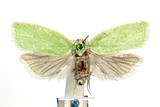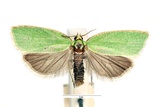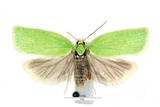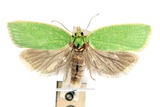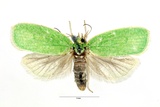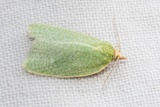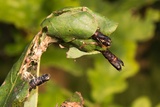Tortrix viridana Linnaeus, 1758 Species
Last modified: Nov. 22, 2025, 2:20 p.m.
A common species throughout Belgium, sometimes become a pest.
Details
- Classification
- Family: Tortricidae > Subfamily: Tortricinae > Tribus: Tortricini > Genus: Tortrix > Species: Tortrix viridana
- Vernacular names
- Groene eikenbladroller (NL), Green Oak Tortrix (EN), la Tordeuse du chêne, Tordeuse verte du chêne (FR), Eichenwickler (DE)
- First mention in Belgium
- De Sélys-Longchamps E. 1844. Énumération des insectes Lépidoptères de la Belgique. — Mémoires de la Société royale des Sciences de Liége 2: 1–35. On page 20.
- Status
-
Native
Distribution
Egg
Eggs are laid in pairs in the crown of the host tree.
Caterpillar
Up to 18 mm. The head varies in color from brown to black and the prothoracic shield varies from near-translucent to black. Darkened pinacula, which are more prominent near the anterior end of the abdomen and on the thorax. Black thoracic legs and an anal comb with eight teeth.
Bionomics
Sometimes the larvae can completely defoliating the crowns. After clear-eating of his natural host plant, larvae disperse and attempt to feed on other deciduous trees. In the first two stages, the larva is feeding in young buds, later rolling the leaves. The eggs hibernate.
The adults can also be found resting in sunshine and are active from dusk onwards and come to light.
Flight periods
The adults fly in one generation a year onwards from late May till early August, occasionally later. Most observations during June.
Observed on
- Host plant (genera):
- Quercus
The larva lives mainly on Quercus with a preference for Quercus robur. Other food plants mentioned in literature are Vaccinium, Urtica, Acer, Carpinus, Fagus, Populus, Salix and Prunus armeniaca.
The species can cause extensive defoliation of oak trees.
Habitat
Present wherever oak occurs.
